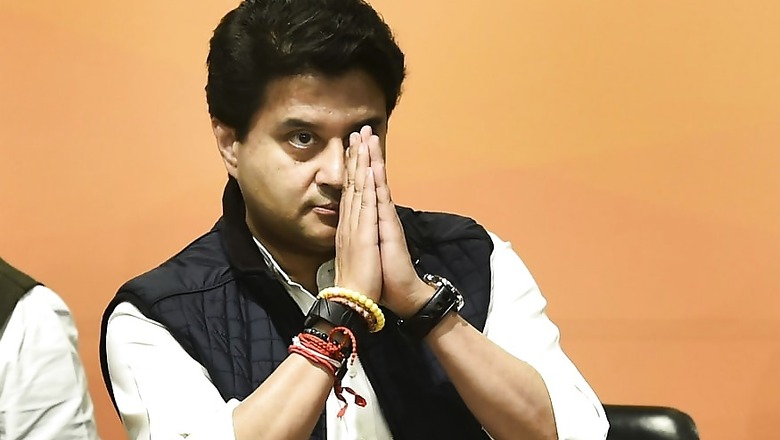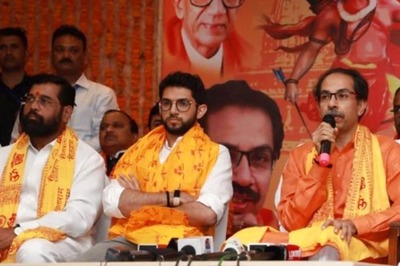
views
Necessitated by Jyoridatiya Scindia’s surprising move to the Bharatiya Janata Party (BJP) from the Congress in March this year, the bye-election for 24 assembly seats in Madhya Pradesh is arguably the most crucial political battle before the state elections in Bihar.
Scindia’s switch to the saffron party initiated a spree of resignations from his supporters and legislators from the MP Congress, which eventually toppled the 14-month-old Kamal Nath-led government in the state.
As both the parties try to out-manoeuvre each other in the bypolls, dates for which are yet to be decided by the Election Commission, speculations are rife over how many turncoats the saffron party would nominate for the election.
Last month, state BJP chief VD Sharma had told ANI that all of the former Congress MLAs who jumped ship were in consideration for candidature for the bypolls.
“These are people who had left their ministerial berths and posts as MLAs to save Madhya Pradesh from corruption and poor administration...I would not be wrong in saying that these people had sacrificed themselves and their posts for the state,” he had said.
Interestingly, data on past elections suggest that turncoats contesting on BJP tickets have had a decent track record when it comes to their strike rate despite electoral setbacks for the BJP in Haryana, Maharashtra, Jharkhand, and Delhi under Modi 2.0.
According to data collated by the Trivedi Centre for Political Data at Ashoka University, five of the 14 turncoats fielded by the BJP during Haryana elections last year won their seats even as the party’s overall tally shrank.
Nine of the 14 turncoats fielded had joined the party from the Indian National Lok Dal (INLD), two had previously been associated with the Congress, and one each came from Haryana Janhit Congress-BL and Shiromani Akali Dal.
Performance of defector candidates was much better in Maharashtra where the BJP eventually lost power to a Shiv Sena-Congress-Nationalist Congress Party (NCP) alliance. Here, 15 of the 20 defectors fielded by the BJP secured their seats for them at a success rate of over 75 per cent. Successful candidates included Kalidasa Nilkanth Kolambkar and senior leader Radhakrishnan Vikhe Patil, both of whom had had three consecutive terms as Congress MLAs.
Overall, 11 of the rebel candidates had switched from the Congress, six from the NCP, and one each came from the Shiv Sena, RSPS, and RPI(A).
Similarly, seven of the 17 rebels fielded by the saffron party in Jharkhand assembly polls late last year emerged victorious. Eleven of these had left the Jharkhand Vikas Morcha (JVM) (which later merged into BJP) to join the party, three had switched from the Congress while three came from other parties.
In a more similar scenario to MP, 11 of the 13 Congress and JD(S) rebels won on a BJP ticket during the Karnataka bye-elections for 15 assembly seats in early December last year. The victory provided the BS Yeddiyurappa-led government stability in the state.
Bypolls in Karnataka had to called when 17 MLAs, 16 of them from the then ruling Congress-JD(S) government, resigned, leading to the fall of the coalition government.
This year in Delhi elections, where the BJP suffered an embarrassing defeat at the hands of the Aam Aadmi Party (AAP), one of the five rebels nominated by the saffron party secured his seat. In total, it won just eight seats of the total 70 that were up for grabs.
Performance of leaders who jumped ship to join the BJP, particularly from the Congress during Prime Minister Modi’s first term at the centre was even more impressive.
A previous analysis by this reporter of state elections held between 2016 and early 2018 during BJP’s first term at the centre showed that a majority of the Congress rebels fielded by the saffron party won their seats.
For instance, during the 2016 assembly elections in Assam, all the seven Congress rebels fielded by the BJP won their seats. This included stalwarts like Himanta Biswa Sarma.
Likewise, during the 2017 state election cycle, all of the Congress defectors that contested on a BJP ticket in Goa and Uttar Pradesh won. In Manipur, Uttarakhand, and Gujarat, the strike rate was 60 per cent, 87 per cent, and 28 per cent respectively. However, none of its two candidates that were Congress rebels succeeded.
In Tripura, where the BJP ended Left’s 25-year-long rule and formed a government for the first time, nine of the 10 Congress rebels that contested as BJP candidates won their seats. These included leaders such as Biswabandhu Sen, Dilip Sarkar and Ratan Lal Nath, each of whom had had consecutive terms in the assembly for the grand old party.
Overall, between the Assam state elections in 2016 and the Tripura elections in early 2018, 36 of the 47 Congress turncoats nominated by the BJP won their respective seats.
With the rise of the saffron wave in the country that began with PM Modi’s election in 2014, experts argue that BJP has emerged as political monopoly where in market-like situation everyone wants to align with the monopoly or the most powerful party, the BJP in this case.
As it stands in the MP assembly, the BJP at present has 107 MLAs while the Congress has 92 legislators in the 230-seat strong house. Although the Shivraj Singh Chouhan-led government has support from the two Bahujan Samaj Party (BSP) MLAs and the lone Samajwadi Party legislator, it would achieve a simple majority on its own if it wins at least nine seats in the upcoming bypolls.
Given its success rate with rebel candidates, the BJP might actually benefit if it plans to field more turncoats.




















Comments
0 comment